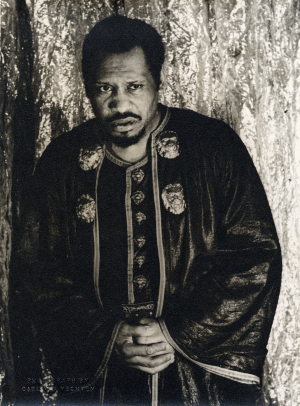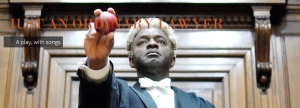
Mainstream media as Iago to our collective Othello
Tayo Aluko writes about the mysterious case of a misidentified(?) Robeson portrait. Image above: Paul Robeson as Othello
Once, many years ago, while touring the US, I happened to be listening to an NPR radio programme about Paul Robeson, with his son Paul Robeson, Jr., as the special guest. It started with a recording of Ol' Man River, Robeson's signature song. As it was playing, I couldn't help feeling that it didn't sound like the great man, but expected to be proved wrong. The presenter said, "That was Paul Robeson singing Ol' Man River," and introduced Paul Jr., who immediately retorted with, "That was NOT my father." I could feel the presenter's embarrassment, and expect a producer got chastised for that grave error.
I fear a number of people are in for similar embarrassment soon, for it has been reported in The Guardian, no less, that a long-lost portrait of Robeson has been rediscovered and will be going on display from May 14 at an exhibition of works by the painter Glyn Philpot at the Pallant House Gallery in Chichester this month.
Once again, I am prepared to be proved wrong, but I am quite sure that the portrait to be displayed is NOT that of Paul Robeson. The only similarity between the portrait's model and Robeson himself is the colour of their skin. That's all. It makes me wonder how such established institutions can be so mistaken, and why nobody else that I know of appears to be challenging the claim.
The portrait is said to have been painted in 1930 while Robeson was playing Othello opposite Peggy Ashcroft at the Savoy Theatre, so we can use one of many pictures from that production, and compare it with the model in the portrait. This is what the gallery director apparently did, but where he saw a likeness, I see only differences. Start with the hairline. Robeson's recedes away from the front in a very much more pronounced way than in the portrait. Robeson sports a goatee (he always did for this role), while the model grows hair on his jaw, not quite joining with the sideburn. Robeson's moustache isn't as luxurious as that of the model. Then, there's the nose. Robeson's is flatter, wider, and tips downwards, unlike that of the model.
The fact that the model's clothing is different from that of Robeson's Othello could potentially be explained away by the possibility that he might have sat for the portrait in rehearsal costume, but how does one account for the anonymous title given the portrait when it was sold in 1944? Robeson had burst into public consciousness when he played a highly acclaimed Joe in Showboat at the Theatre Royal, Drury Lane in 1928. He became a regular in concert halls all over the UK thereafter, and a much sought-after celebrity. And yet, his portrait is sold with the title "Head of a Negro?" Highly unlikely.
But the Guardian says it is Robeson, so it must be, right? I beg to differ, and would say that this appears to be a case of people wanting so badly to believe something to be true, that they ignore all evidence to the contrary. If I am right, this would be another case of a journalist and editors accepting information from a source and reproducing it without doing their own checks. The Guardian won't be alone in this, and indeed all of mainstream media, the BBC included, are accused by many of being complicit in peddling untruths fed to it by the global elite to such an extent that they are complicit in creating many of the world's ills.
We saw it in Robeson's time, when in 1949, he made a speech in Paris in which he questioned why African Americans would fight against the Soviet Union (America's ally until the end of WWII, and the place where he first felt the absence of racism), when they were second-class citizens in their own country. The press first distorted the speech to make it sound deliberately unpatriotic, and then whipped up anti-Black, anti-Semitic and anti-Communist sentiment to such an extent that by the time Robeson returned to his country, he had turned from being the most popular and successful artist to the most hated. This culminated in the infamous Peekskill Riots of August and September 1949: an episode from which he was lucky to emerge alive. The following year, his passport was cancelled, and it would be another eight years before he was able to tour again. His health, his career and his reputation never fully recovered after that.
Remarkably, for one who was probably the most famous American of his day, Robeson is almost a forgotten figure today. It is therefore always a welcome sight when his name and story pop up, even if it is to use him (erroneously in my view) to promote an art exhibition.
Undermining Jeremy Corbyn
Another person who fell spectacularly from grace, thanks partly to mainstream media, is Jeremy Corbyn. What is interesting in his case is how selectively he is either ignored or remembered since his demise. Most of the time, it is as though he never existed, and you won't hear or read about him in the papers or in the news, even from people in the Labour Party he once led. Forgotten is the fact that under him, the Party became the largest political party in Europe. Forgotten, that when a snap General Election was called by Theresa May in 2017, Corbyn's Labour came barely 2000 votes short of victory. Forgotten, that following that powerful showing, people within the Party itself set about undermining him in collusion with the media and other Establishment figures to such an extent that by the time of the 2019 election, so much of the public had been turned against him and the Party that they badly lost the election.
It has also been forgotten that a report commissioned by the Party (never officially published but leaked) has documented the Party officials' and MPs' machinations. A further report commissioned into the leaking of that first report has, strangely, been repeatedly delayed. In the meantime, it has been acknowledged in a single programme on the BBC that there was never any evidence of anti-Semitism by Corbyn himself; and for an authoritative summary of why the allegations of anti-Semitism were either manufactured or grossly exaggerated, one has to go to the blog of a lone campaigner, Simon Maginn, to see how and why #ItWasAScam.
And when Labour, under its new, particularly uncharismatic and apparently unprincipled leader, Keir Starmer, performed poorly (and even worse than under his predecessor) in the recent Council elections, many current MPs and pundits have resurrected Jeremy Corbyn's name for the sole purpose of blaming him for the defeat of 2019 that they themselves had engineered! The haemorrhaging of members and funds from the Party since his departure seem not to trouble them as they prepare for the 2024 General Elections.
There are many more examples of politicians and elites using the media to persuade us to do or accept things that are palpably bad for us, others and/or the planet, whether through misinformation, obfuscation or suppression: the Iraq War; the Afghan War; Palestine; Yemen; the last US President and Julian Assange being just a few examples.
This indeed recalls Shakespeare's Othello, in which our tragic hero is persuaded by the constant whispering deceit of Iago into succumbing to "the green-eyed monster," and murdering his innocent young wife. While being nowhere near as serious or consequential a case of misinformation as many, this error by the Guardian in accepting (if I am right) the misidentification of Head of A Negro as Paul Robeson is another reason for us to "beware of the mainstream media."

